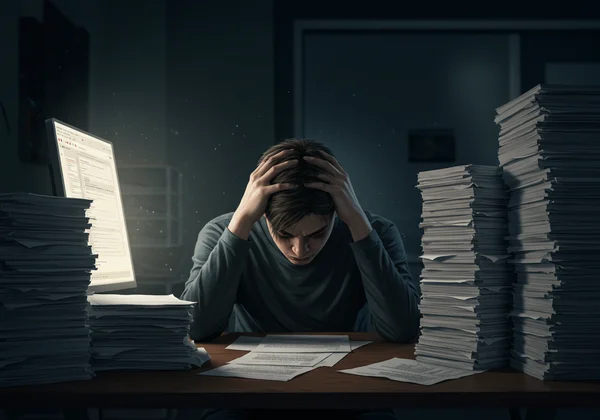Anhedonia Test vs. Burnout: Understanding Emotional Exhaustion
Feeling drained, unmotivated, and finding little joy in activities you once loved can be incredibly confusing and isolating. You might find yourself wondering if you're just overworked or if something deeper is at play. This is a common crossroads where many people struggle to distinguish between two powerful states: anhedonia and burnout. Understanding the difference is the crucial first step toward finding the right path forward. So, how do you know if you're just exhausted or if you've genuinely lost the ability to feel joy?
Here, we'll untangle the complex symptoms of anhedonia vs burnout, exploring their definitions, signs, and core differences. This clarity can empower you to understand your emotional state and begin your journey to rediscover joy.
Anhedonia: The Pervasive Loss of Pleasure and Joy
Anhedonia isn't just feeling sad or having a bad day; it's a profound inability to experience pleasure. It’s a core symptom of major depressive disorder but can also exist on its own. Imagine your favorite song comes on, but you feel nothing. A friend tells a hilarious joke, but you can't muster a genuine laugh. This emotional flatness is the hallmark of anhedonia.

What is Anhedonia? Beyond Simply "Feeling Flat"
At its core, anhedonia is a deficit in your brain's reward system. When you do something enjoyable, your brain typically releases dopamine, making you feel good and motivating you to repeat the behavior. In anhedonia, this circuit is dampened. It's not that the world stops offering pleasurable experiences; rather, it's your capacity to perceive and feel them that diminishes. It feels less like sadness and more like an absence of feeling altogether—an emotional numbness that blankets everything.
Common Signs and Symptoms of Anhedonia
Recognizing the signs of anhedonia is key to understanding it. While experiences vary, common symptoms include:
- Loss of interest in hobbies and pastimes you once cherished.
- Feeling detached or indifferent during social interactions.
- A reduced desire for physical intimacy or affection.
- Food tasting bland or unappealing.
- Struggling to feel positive emotions like happiness, excitement, or love.
- Difficulty finding motivation for tasks, as there is no anticipated reward.
Types of Anhedonia: Social vs. Physical Anhedonia
Anhedonia can manifest in distinct ways, primarily categorized into two types. Understanding these can help you pinpoint your experience more accurately.
- Social Anhedonia: This involves a diminished interest and pleasure in social situations. You might withdraw from friends, find conversations taxing, or feel no reward from connecting with others. It's not about being shy or introverted; it's about social engagement no longer feeling good.
- Physical Anhedonia: This is the inability to experience pleasure from physical sensations. This can include anything from the taste of a delicious meal and the comfort of a warm hug to the enjoyment of music or the satisfaction of exercise.
Burnout: When Chronic Stress Leads to Exhaustion
Burnout, in contrast, is an occupational phenomenon resulting from chronic, unmanaged workplace stress. It’s a state of emotional, physical, and mental exhaustion. While it often originates from work, its effects can spill over into every aspect of your life, leaving you feeling cynical, detached, and ineffective.

What Does Burnout Really Feel Like? The Stages of Exhaustion
Burnout isn't something that happens overnight. It's a gradual process that builds over time. The experience is often characterized by three main dimensions:
- Exhaustion: A profound sense of being physically and emotionally drained. You may feel tired all the time, regardless of how much you sleep.
- Cynicism and Detachment: A growing sense of negativity and emotional distance from your job and colleagues. You might feel irritable and lose your sense of purpose.
- Inefficacy: A feeling of incompetence and a lack of achievement. You start to doubt your abilities and feel that your contributions no longer matter.
Common Causes and Triggers of Burnout
While a demanding job can contribute, the causes of burnout are often more complex than just working long hours. Key triggers include:
- Lack of control or autonomy over your work.
- Unclear job expectations or a dysfunctional workplace dynamic.
- A significant mismatch in values between you and your employer.
- Extremes of activity, such as a monotonous or chaotic workload.
- A lack of social support and poor work-life balance.
The Impact of Untreated Burnout on Your Life
If left unaddressed, burnout can have serious consequences. It can impact your physical health, leading to issues like insomnia and a weakened immune system. Emotionally, it can make you more vulnerable to anxiety and depression. It erodes your motivation and can damage your personal relationships as you withdraw and become more irritable.
Anhedonia vs. Burnout: Spotting the Key Differences
While they share overlapping symptoms like low motivation and social withdrawal, the core distinction between anhedonia and burnout is critical. Burnout is primarily an energy and stress problem; anhedonia is a pleasure problem. One is about being "used up," while the other is about being "numb."

Disentangling the Symptoms: A Side-by-Side Comparison
Here’s a simple table to help you tell the difference between the two conditions:
| Feature | Anhedonia | Burnout |
|---|---|---|
| Core Feeling | Inability to feel pleasure or joy (numbness). | Overwhelming exhaustion and lack of energy. |
| Origin | Often linked to depression, trauma, or neurological factors. | Primarily caused by chronic, unmanaged stress (often work-related). |
| Scope | Pervasive across all areas of life (work, hobbies, relationships). | Typically starts in a specific context (like work) and may spread. |
| Emotional Response | A flat, muted emotional landscape. | Feelings of cynicism, frustration, and detachment. |
| Hope/Motivation | Belief that even enjoyable activities won't bring pleasure. | Belief that if the stressor was removed, enjoyment could return. |
The Core Mechanism: Pleasure Loss vs. Energy Depletion
The most fundamental difference lies in the underlying mechanism. With burnout, you might desperately want to enjoy a weekend getaway with friends, but you simply lack the physical and emotional energy to do so. You can still imagine it being fun. With anhedonia, you lack the very capacity to derive pleasure from the experience, regardless of your energy levels. The thought of the trip doesn't spark any joy because your pleasure circuits are offline. If you feel this disconnect, it may be time to assess your symptoms.
Can You Experience Both Anhedonia and Burnout?
Yes, absolutely. The relationship between the two can be complex. Chronic, untreated burnout can be a major risk factor for developing major depressive disorder, and anhedonia is a primary symptom of depression. The relentless stress and exhaustion of burnout can eventually wear down your brain's reward system, leading to a genuine loss of pleasure.
Moving Forward: When to Seek Help and How Our Test Can Guide You
Understanding whether you're dealing with anhedonia, burnout, or both is the first step toward recovery. Clarity empowers you to seek the right kind of support and take meaningful action.
Understanding Your Experience: The First Step
Simply putting a name to what you're feeling can be incredibly validating. It shifts the narrative from "What's wrong with me?" to "What can I do about this?" Self-awareness is not the final destination, but it is the essential starting point for any journey toward better mental health.
Taking the Anhedonia Test: Get Instant, Confidential Insights
If you suspect you might be experiencing anhedonia, gaining objective insight is a powerful next step. The free anhedonia test available on our site offers a scientific and accessible way to screen for these symptoms. Based on the widely used Snaith-Hamilton Pleasure Scale (SHAPS), our test is:
- Completely Anonymous: No registration or personal information is required.
- Scientifically Based: Provides reliable insights based on a clinically recognized tool.
- Instant & Clear: Receive an easy-to-understand summary of your results immediately after completion.
This test can serve as a valuable, private resource to help you understand your emotional state.

Professional Guidance: When to Talk to a Doctor or Therapist
Remember, an online screening tool offers information and is not a substitute for a professional diagnosis. Whether your results suggest anhedonia or you identify strongly with the symptoms of burnout, speaking with a doctor, psychologist, or licensed therapist is the recommended next step. They can provide a comprehensive evaluation, an accurate diagnosis, and a personalized treatment plan to help you heal.
Rediscover Your Capacity for Joy: Your Journey Starts with Clarity
Distinguishing between anhedonia and burnout is more than just a diagnostic exercise—it's about understanding the nature of your struggle so you can navigate it effectively. Burnout signals a need to address external stressors and reclaim your energy. Anhedonia points to a deeper, internal challenge with your capacity for pleasure that often requires targeted therapeutic support.
Your path back to a life filled with engagement and joy truly begins with understanding. Don't let confusion hold you back any longer—start your journey today.
Frequently Asked Questions About Anhedonia & Burnout
How do you test for anhedonia?
A clinical diagnosis is made by a mental health professional through interviews and assessments. However, a great first step is using a scientific screening tool. The online anhedonia test on our website is based on the SHAPS scale and can provide confidential, instant insights into your symptoms.
Does anhedonia ever go away?
Yes, with the right support and treatment, many people can overcome anhedonia. Treatment often involves therapy (like Cognitive Behavioral Therapy or Behavioral Activation), medication that targets neurotransmitter systems, and lifestyle changes. The key is addressing the underlying cause.
What deficiency causes anhedonia?
Anhedonia is complex and not linked to a single deficiency. However, it's strongly associated with dysregulation in the brain's dopamine system, which is crucial for reward and motivation. Nutritional deficiencies, such as low levels of Vitamin D, B vitamins, or zinc, can also impact mood, but they are rarely the sole cause.
What worsens anhedonia?
Chronic stress, social isolation, poor sleep, and a lack of physical activity can all exacerbate the symptoms of anhedonia. Additionally, substance use can interfere with the brain's reward pathways, making it more difficult to experience natural pleasure.